A captivating blend of ancient ruins, breathtaking art, and lively street scenes, Italy’s passionate capital stands as one of the world’s most romantic and charismatic cities.
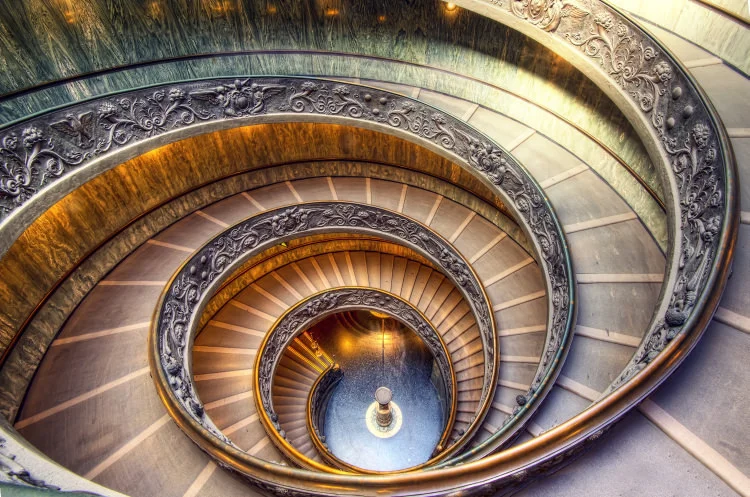
Home to the Sistine Chapel and countless priceless masterpieces, the Vatican Museums (Musei Vaticani) form one of the world’s largest and most visited museum complexes. Spanning 7km of galleries and 26 museums, the collection reflects centuries of papal patronage and artistic legacy.
Housed within the opulent Palazzo Apostolico, a sprawling complex of two interconnected palaces, the museums showcase classical sculptures, Renaissance frescoes, and ancient treasures. Highlights include the Laocoön, Apollo Belvedere, Raphael’s Rooms, and the crown jewel—Michelangelo’s Sistine Chapel.
Founded in the early 1500s by Pope Julius II, the museums began with a collection of classical sculptures displayed in the Cortile Ottagono. Julius later commissioned Raphael and Michelangelo to decorate key areas of the Vatican Palace. The collections expanded over centuries, notably under Pope Gregory XVI in the 1830s and again during John Paul II’s extensive restoration efforts ahead of the 2000 Jubilee.
A three-hour visit covers major highlights:
Start at Cortile delle Corazze, pass through Cortile della Pigna to reach the Museo Pio-Clementino, home to iconic sculptures in the Octagonal Courtyard.
Continue through the Greek Cross Room and climb to the Gallery of the Candelabra, then proceed to the Tapestry Gallery and the breathtaking Map Gallery.
From there, visit the Raphael Rooms, featuring the renowned School of Athens, before reaching the finale: the Sistine Chapel.
This sacred space holds Michelangelo’s two masterpieces—the ceiling frescoes (1508–12) and the Last Judgment (1536–41). The ceiling’s nine Genesis scenes, especially The Creation of Adam, remain some of the most celebrated images in Western art. The Last Judgment, on the west wall, dramatically depicts the fate of souls. Side walls feature works by Botticelli and Perugino, including The Handing Over of the Keys.
Don’t miss:
The Pinacoteca, with works by Raphael and da Vinci.
The Braccio Nuovo, showcasing the Nile statue surrounded by children.
The Egyptian and Etruscan Museums, offering a rich glimpse into ancient civilizations.
Tickets: €17 (plus €5 online booking fee). Pre-booking is strongly advised to skip long queues.
Tours: Official guided tours (including Vatican Gardens and after-hours Sistine Chapel visits) are available on the official site.
Opening Hours: Mon–Sat, 9am–6pm; last Sunday of the month, free entry till 2pm (very crowded).
Dress Code: Modest attire required—no bare shoulders or short skirts.
Photography: Allowed without flash or tripods, except in the Sistine Chapel.
There’s no guaranteed quiet time, but Tuesday and Thursday afternoons are usually less crowded. Wednesday mornings may be calmer due to the pope’s weekly audience.
Inside the museum, there are cafeterias and a bistro in Cortile della Pigna. Just outside, Bonci Pizzarium is a popular spot for exceptional pizza al taglio.
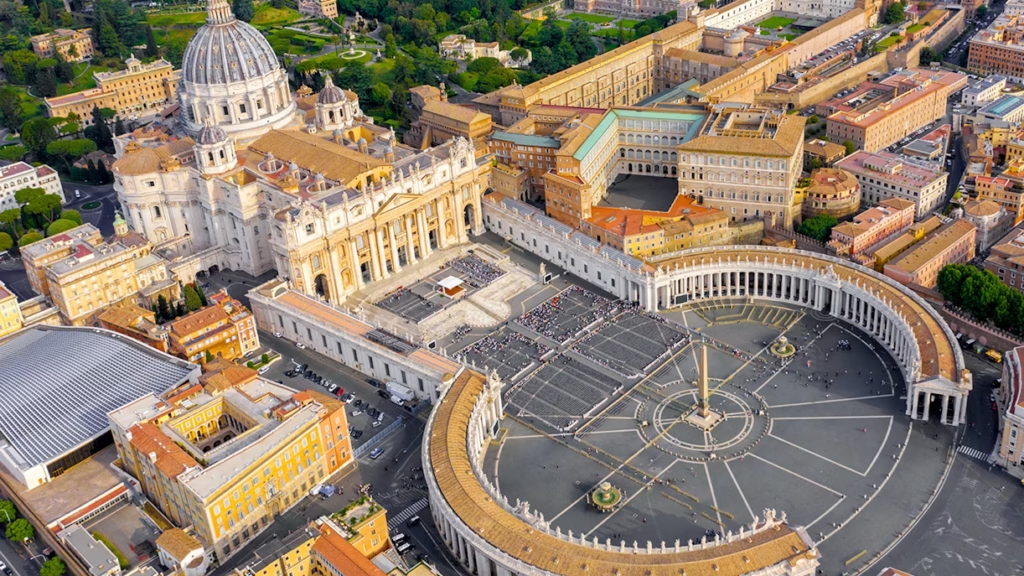
Even in a city filled with remarkable churches, St Peter’s Basilica stands apart. The Vatican’s iconic basilica is a marvel of religious devotion, artistic grandeur, and architectural brilliance—from the sweeping embrace of its piazza to its ornate façade and awe-inspiring interior.
Inside the basilica are two of Michelangelo’s most acclaimed masterpieces: the Pietà, sculpted when he was just 25, and the magnificent dome that dominates Rome’s skyline. His dome is not only an architectural triumph but also a symbol of the Renaissance’s spiritual ambition.
The original church, built around 349 CE by Emperor Constantine, stood on the site believed to be St Peter’s burial place. By the 15th century, it had fallen into ruin. A major rebuilding project began in 1506, but progress was slow. Bramante’s initial plans stalled after his death, with other renowned architects, including Raphael, struggling to move the project forward.
In 1547, Michelangelo took over. He simplified the plans and designed the iconic dome. Though he died before it was completed, his vision was realized by Giacomo della Porta and Domenico Fontana in 1590. Later, Carlo Maderno extended the nave and created the basilica’s monumental façade. The church was finally consecrated in 1626.
Take a moment to admire Maderno’s grand façade, built between 1608 and 1612. It rises 48m high and stretches 115m wide. At the top, 13 statues depict Christ the Redeemer, John the Baptist, and the apostles. The central balcony—Loggia della Benedizione—is where the pope gives his Urbi et Orbi blessing on Easter and Christmas.
A Latin inscription across the entablature commemorates Pope Paul V, under whose watch the façade was completed.
Step inside the 187m-long basilica to discover over 15,000 sq m of magnificent artwork and architecture.
The Pietà: On the right as you enter, Michelangelo’s only signed work captures Mary cradling the body of Christ in haunting beauty.
Charlemagne’s Coronation Site: A red disc on the floor marks where Charlemagne and later emperors were crowned.
Bernini’s Baldachin: Towering above the main altar, this 29m bronze canopy—cast using metal from the Pantheon—is both majestic and symbolic. It stands directly above the tomb of St Peter.
Michelangelo’s Dome: Inspired by Brunelleschi’s in Florence, the 119m-high dome is supported by four giant piers adorned with statues of saints: Longinus, Veronica, Helena, and Andrew.
St Peter Statue: At the base of the Pier of St Longinus, pilgrims flock to touch the foot of Arnolfo di Cambio’s 13th-century bronze statue of St Peter, now worn smooth.
Museo del Tesoro (€5): Located off the left nave, this treasury includes sacred relics like a Donatello tabernacle and the gem-encrusted Crux Vaticana from the 6th century.
Vatican Grottoes: Beneath the basilica, this free-to-enter area contains the tombs of popes and remnants of the original 4th-century church.
St Peter’s Tomb & Necropolis: A guided tour (€13) through the Ufficio Scavi offers rare access to the ancient necropolis and the presumed burial site of St Peter.
For sweeping views of Rome, climb to the top of St Peter’s dome. You can take a lift partway (for €10) or ascend all 551 steps (€8). The staircase gets narrow and steep—best avoided if you’re claustrophobic or afraid of heights.
To witness a mass celebrated by the pope, request free tickets in advance from the Prefecture of the Papal Household. These are especially popular during major events like Easter and Christmas.
Opening Hours: Daily, 7am–6:30pm (7pm in summer). Entry is free but requires security checks.
Best Time to Visit: Avoid long lines by coming at lunchtime or in the late afternoon.
Dress Code: Strictly enforced—no bare shoulders, mini-skirts, or short shorts.
Free Guided Tours: Seminarians from the North American College offer two-hour tours (Mon–Thu, 2:15pm). No booking needed—check online for updates.
Take Metro Line A to Ottaviano, or bus 40 or 64 from Termini Station.
Skip the tourist traps around the basilica and head into Prati, a stylish neighborhood:
Re-bìo: Organic salads and panini for a quick, healthy bite.
Il Sorpasso: A favorite local spot for a more relaxed meal with modern Roman flair.
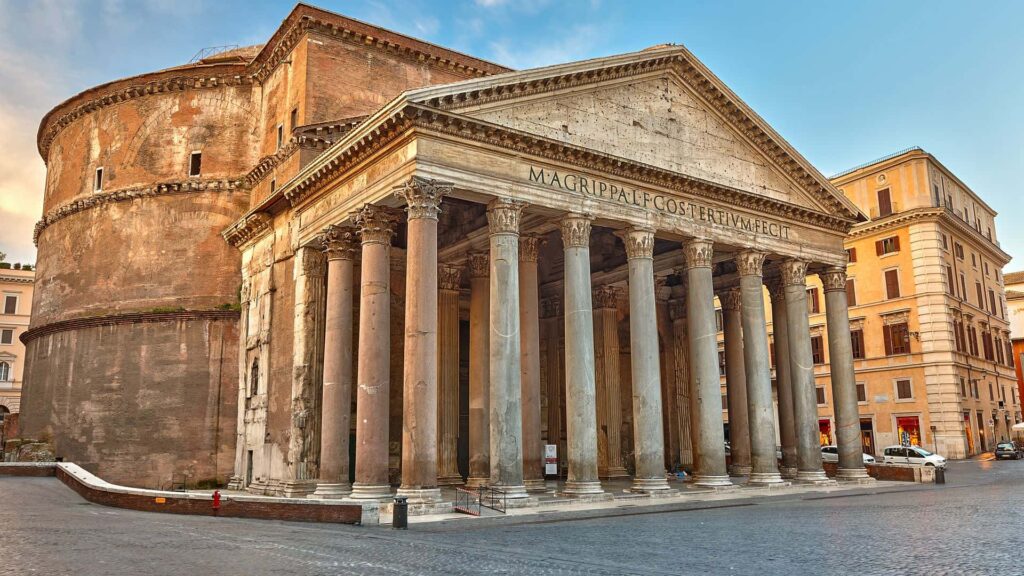
A remarkable 2,000-year-old temple-turned-church, the Pantheon is not only Rome’s best-preserved ancient monument but also one of the most influential buildings in Western architectural history.
Commissioned by Emperor Hadrian around 125 CE on the site of Marcus Agrippa’s earlier temple, the Pantheon continues to awe visitors with its grand proportions, celestial design, and spiritual resonance. While its weathered exterior hints at its age, stepping through its massive bronze doors into the vast rotunda is nothing short of breathtaking.
At the heart of the Pantheon is its iconic dome—a record-breaking structure for centuries—culminating in a 9-meter-wide oculus that opens directly to the sky. This architectural “eye” floods the interior with natural light, casting dramatic rays over the marble-clad walls and royal tombs below.
The Pantheon’s design has inspired architects for generations. Its symmetrical layout, harmonious geometry, and engineering brilliance—especially the lightened concrete mix used to support the giant dome—set a benchmark for sacred architecture.
The building was originally dedicated to all Roman gods (hence Pantheon, from the Greek pan = all, theos = gods). But in 609 CE, it was consecrated as a Christian church, the Basilica di Santa Maria ad Martyres. This transformation is what saved it from the decay that befell many other Roman structures.
For centuries, the inscription on the front of the building—M·AGRIPPA·L·F·COS·TERTIVM·FECIT (“Marcus Agrippa, son of Lucius, built this in his third consulate”)—led people to believe the structure was Agrippa’s original. Only later excavations confirmed that Hadrian rebuilt the temple but kept the original dedication.
Despite surviving medieval times relatively intact, the Pantheon did suffer some losses. In 1625, Pope Urban VIII ordered the removal of its bronze roof tiles and portico metal to repurpose for Bernini’s baldachin at St Peter’s. Romans famously quipped, “What the barbarians didn’t do, the Barberini did.”
The Pantheon’s portico is an imposing sight. Sixteen monolithic Corinthian columns—each nearly 12 meters high and carved from Egyptian granite—support a triangular pediment. Behind this is the massive rotunda, once faced in marble, with rivets and scars on the brick exterior hinting at long-lost decorative panels.
The interior, clad in patterned marble and bathed in natural light, feels both majestic and serene. Among the notable tombs here are:
Raphael, the Renaissance master
Vittorio Emanuele II, the first king of unified Italy
Umberto I, his son and successor
During the Renaissance, architects like Brunelleschi studied the Pantheon closely, with its dome influencing his famous design in Florence.
Opening Hours: Daily, 9am–7pm (last entry 6:45pm)
Entry Fee: €5 (from July 1, 2023); booking required for weekends and holidays via the official website.
Closed: January 1 and December 25
Mass Times: No tourist visits during services—Saturdays at 5pm and Sundays at 10:30am.
Audio Guide: €10
Guided Tours: Start from €20
Special Tradition: On Pentecost, thousands of red rose petals are dropped through the oculus, symbolizing the descent of the Holy Spirit—an unforgettable experience if you’re lucky to witness it.
You’re spoiled for choice around the Pantheon:
La Casa del Caffè Tazza d’Oro: A Roman institution for espresso lovers—don’t miss the granita al caffè in summer.
Sant’Eustachio Il Caffè: Another legendary café, famous for its rich, velvety brew.
Ginger: Just across from the Pantheon, this modern spot offers fresh sandwiches, gourmet burgers, and casual meals in a stylish setting.
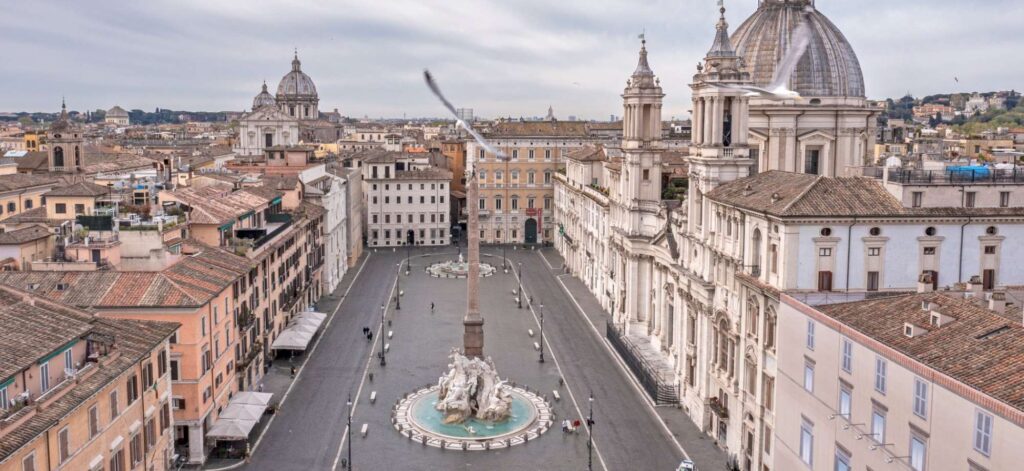
Bursting with baroque beauty, playful fountains, and a lively mix of artists, performers, and visitors, Piazza Navona is one of Rome’s most iconic and atmospheric squares. Built on the site of the 1st-century Stadio di Domiziano, the piazza was paved over in the 15th century and served as Rome’s main market for nearly 300 years.
Today, it’s a stage for elegance and street life—best experienced early in the morning before the crowds descend, or after dark when the fountains glow under soft illumination. Don’t forget to take a sip from the nasone (“big nose”) public drinking fountain at the square’s northern end.
In December, the piazza becomes even more magical with its traditional Christmas market, which runs until January 6, bringing festive cheer and seasonal treats.
The square’s centerpiece is the flamboyant Fontana dei Quattro Fiumi (Fountain of the Four Rivers), created by Gian Lorenzo Bernini in 1651. At its heart rises an Egyptian obelisk, flanked by dramatic sculptures representing the Nile, Ganges, Danube, and Plate rivers. Legend has it that the figure of the Nile covers his face to avoid seeing the nearby Chiesa di Sant’Agnese in Agone, designed by Bernini’s rival Borromini. In reality, Bernini completed his work two years before the church facade was even started—the gesture simply symbolizes the unknown source of the Nile at the time.
At the southern end stands the Fontana del Moro, designed by Giacomo della Porta in 1576. Bernini later added the central Moor figure in the 17th century, while the surrounding tritons are 19th-century additions. To the north, the Fontana del Nettuno features Neptune battling a sea monster, surrounded by elegant sea nymphs.
Chiesa di Sant’Agnese in Agone: A masterpiece of baroque architecture by Borromini, this church boasts a theatrical facade and richly adorned dome. It marks the spot where Saint Agnes is said to have performed a miracle before her martyrdom. According to legend, her hair grew miraculously to cover her body after she was stripped, preserving her modesty. The church also hosts regular classical music concerts.
Palazzo Pamphilj: Commissioned by Giovanni Battista Pamphilj (later Pope Innocent X), this striking baroque palace was built between 1644 and 1650 by Borromini and Rainaldi. Inside are impressive frescoes by Pietro da Cortona. Today, it houses the Brazilian Embassy and can be visited by pre-booked guided tours.
Beneath all of this lies the ancient Stadio di Domiziano, once a 30,000-seat venue for athletic competitions. Its underground remains—accessible from Via di Tor Sanguigna—remind us that the name Navona comes from “agon”, the Greek word for games.
The area around Piazza Navona, Campo de’ Fiori, and the Pantheon offers a wide mix of dining options—from upscale restaurants and cozy trattorias to gelaterie and street food spots. Be wary of overpriced tourist traps, but a short stroll can lead you to culinary gems.
Vivi Bistrot: Nestled on the ground floor of Palazzo Braschi at the piazza’s southern end, this charming spot is ideal for a light lunch.
Etablì: Tucked into the streets west of the square, this stylish bar-restaurant offers a relaxed vibe with modern Italian fare.
For something more traditional, head south to the Jewish Ghetto, renowned for its Roman-Jewish cuisine and rich culinary heritage.
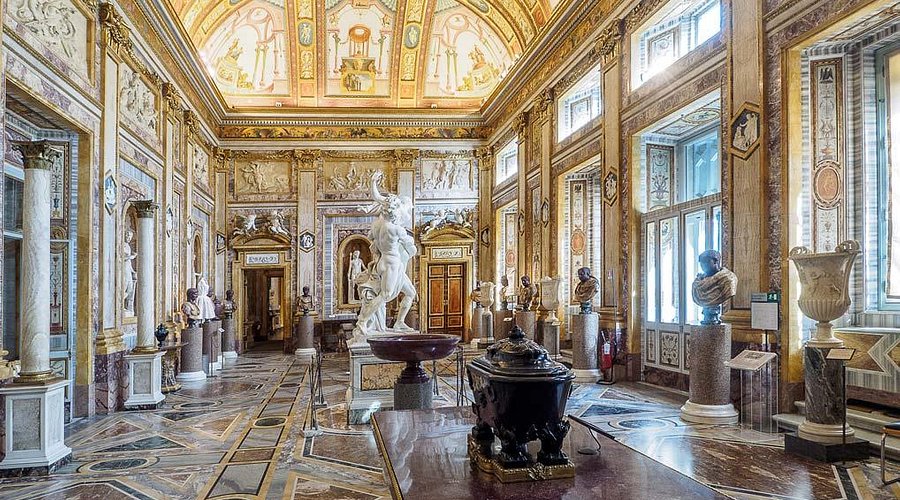
If you’re only visiting one art gallery in Rome, make it the Galleria Borghese. Often hailed as the “queen of private art collections,” it features masterpieces by Caravaggio, Raphael, and Titian, as well as extraordinary sculptures by Gian Lorenzo Bernini. Among its most celebrated works are Bernini’s emotionally charged Rape of Proserpina and Canova’s sensuous Venus Victrix, a reclining portrait of Napoleon’s sister.
The collection was established by Cardinal Scipione Borghese (1577–1633), an avid and often aggressive art collector of his time. Originally housed near St Peter’s, the artworks were moved in the 1620s to his newly built villa just outside Porta Pinciana—now known as Villa Borghese. The collection remains on view in the Casino Borghese, the villa’s central building.
Over the centuries, the villa has seen several redesigns, most notably under Prince Marcantonio Borghese in the late 1700s, who added much of the opulent neoclassical decor visitors admire today.
The museum is split into two sections:
The Ground Floor features stunning sculptures, ancient mosaics, and elaborate ceiling frescoes.
The Upper Floor (Pinacoteca) houses the picture gallery, rich in Renaissance and Baroque paintings.
Your visit begins with the grand entrance hall, where mosaic floors depict ancient gladiator scenes, and Pietro Bernini’s Falling Horse and Rider defies gravity on the wall. Look for the 2nd-century Satyr and other antiquities as you ascend.
Sala I: Admire Antonio Canova’s famous sculpture of Paolina Borghese as Venus Victrix—an elegant and daring portrait of Napoleon’s sister.
Sala III: Bernini’s Apollo and Daphne captures the exact moment of Daphne’s transformation into a laurel tree—pure sculptural poetry.
Sala IV: The Rape of Proserpina showcases Bernini’s genius in marble. Pluto’s gripping hand pressing into Proserpina’s thigh is so lifelike it almost feels real.
Sala VIII: A shrine to Caravaggio, with powerful works like:
Boy with a Basket of Fruit (1593–95)
David with the Head of Goliath (1609–10), where Goliath’s head is thought to be a self-portrait
St John the Baptist (possibly his final painting)
Madonna with the Serpent and Young Sick Bacchus
The upper floor offers a rich survey of Renaissance painting:
Sala IX: Don’t miss Raphael’s Deposition of Christ (1507) and Lady with a Unicorn (1506).
Also in this room are:
Fra Bartolomeo’s Adoration of the Christ Child (1495)
Perugino’s Madonna and Child
Sala X: Discover Correggio’s sensual Danaë (1530–31)
Sala XIV: Bernini’s rare self-portraits
Sala XX: Titian’s masterpiece Sacred and Profane Love (1514), a rich allegory of love and virtue
Timed Entry Only: Visits are strictly scheduled in two-hour slots to control crowding. Advance booking is essential.
Tickets: €13 (plus a €2 reservation fee), available on the official museum website.
Audio Guide: Available for €5 from the basement area, where you’ll also find coat check and a small café.
Closed: Mondays
Pro Tip: Book the earliest slot of the day to enjoy the gallery’s masterpieces in relative quiet—and give yourself time to linger. The museum is set in Villa Borghese Gardens, a perfect spot for a relaxed stroll or picnic after your visit.
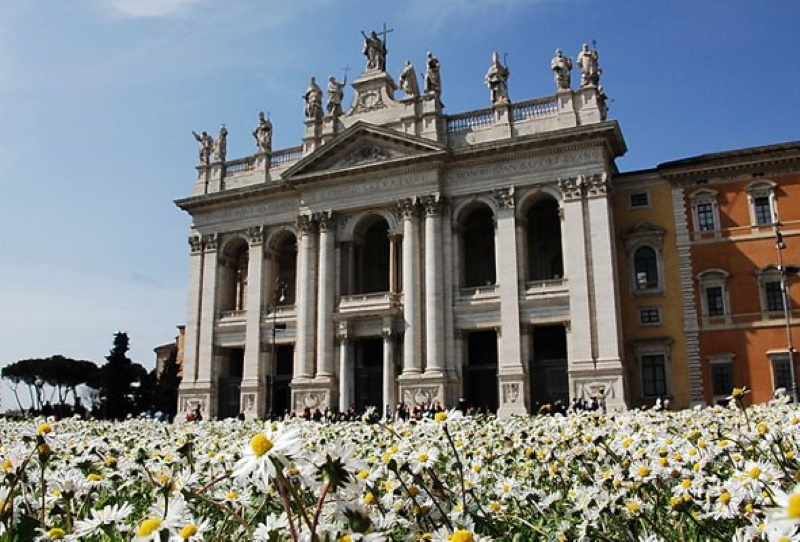
Long before St Peter’s Basilica took center stage, San Giovanni in Laterano was the most important church in the Christian world. Commissioned by Emperor Constantine and consecrated in AD 324, it was the first Christian basilica built in Rome—and for more than a millennium, it served as the papal seat and primary church of the pope, who remains its bishop to this day. Officially, it is still Rome’s cathedral, making it a must-see for those seeking the spiritual heart of Catholicism.
The basilica was built atop the site of an earlier structure known as San Salvatore, constructed shortly after Constantine’s Edict of Milan legalized Christianity across the Roman Empire. Over time, San Giovanni in Laterano suffered damage through invasions, fires, and conflicts, and it has been rebuilt several times.
The current design largely dates back to the 17th century, when Pope Alexander VII commissioned Francesco Borromini—one of Rome’s great baroque architects—to redesign the church for the 1650 Holy Year. Borromini retained several elements of the older structure, including the mosaic floor, apse decorations, and the beautiful ciborium above the main altar. The monumental facade, with its soaring statuary, was completed later by Alessandro Galilei in 1732.
San Giovanni in Laterano stuns from the moment you approach. Its majestic facade is crowned by 15 statues, including Christ, Saints John the Baptist and John the Evangelist, and the Twelve Apostles.
Main Entrance & Holy Door: The bronze doors were taken from the Curia in the Roman Forum. On the far right is the Holy Door, opened only during Jubilee years.
Interior: Inside, the vast nave is lined with 4.6m-tall statues of the apostles, while the gilded coffered ceiling and mosaic floors reflect centuries of craftsmanship.
High Altar & Baldachin: Beneath the richly decorated Gothic canopy lies the high altar, traditionally used by the pope. It’s believed to house relics of St Peter and St Paul.
Confessio & Relics: A stairway beneath the altar leads to the confessio, where you’ll find a wooden statue of St John the Baptist and the Renaissance tomb of Pope Martin V.
Apse Mosaics: Behind the altar, the apse is adorned with luminous mosaics—some dating to the 4th century, others added during the 19th century.
Giotto Fresco & Pope Sylvester II Monument: In the right-hand aisle, look for a fragmentary Giotto fresco. Nearby is a monument to Pope Sylvester II, rumored to creak or sweat when a pope is near death.
Cloister: Don’t miss the peaceful 13th-century cloister, with its elegant twisted columns and tranquil central garden.
Entry to the basilica is free, and it’s open daily to all visitors.
Palazzo Lateranense Museum: Adjacent to the church, this museum showcases liturgical treasures, religious relics, and personal items of past popes. It’s well worth a visit for those interested in Church history.
Tickets for guided tours are €17.50, bookable via the museum’s official website.
Gift Shop: Accessed near the apse, it also leads to the small Museo del Tesoro, featuring vestments and sacred artifacts.
Pro Tip: Visit in the late morning for quieter views of the interior, and don’t miss a stroll through the surrounding Lateran complex, which includes the Scala Sancta (Holy Stairs), believed to be the steps Christ ascended during his trial before Pontius Pilate.
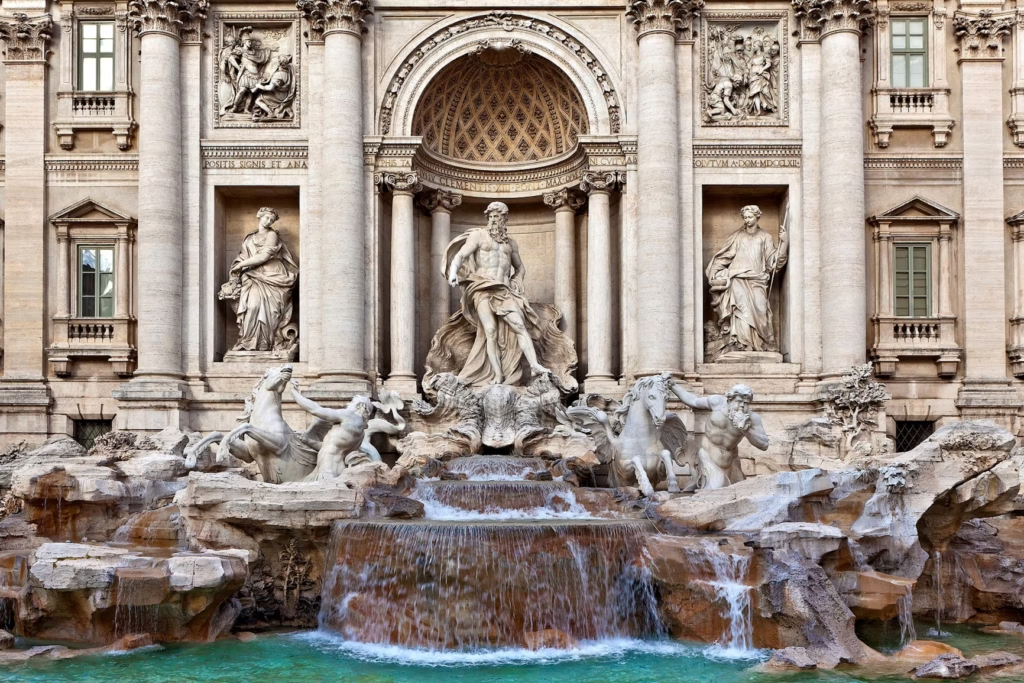
A baroque masterpiece bursting with theatrical flair, the Fontana di Trevi (Trevi Fountain) is Rome’s most celebrated fountain and one of its most photographed landmarks. Set against the dramatic backdrop of the Palazzo Poli, this 18th-century fountain draws thousands of visitors daily—all eager to toss a coin into its waters in the hope of one day returning to the Eternal City. It’s more than a superstition: around €3,000 ($3,250) is collected from the fountain every day.
The current fountain was designed by Nicola Salvi in 1732 and completed by Giuseppe Pannini three decades later. Its dramatic central figure is Oceanus, the sea god, standing in a shell-shaped chariot drawn by two horses—one calm, one wild—each led by a Triton. The two horses symbolize the changing moods of the sea.
Flanking Oceanus are statues of Abundance and Salubrity, while water still flows from the Aqua Virgo, an ancient Roman aqueduct built in 19 BCE. The name Trevi comes from “tre vie”—the “three roads” that historically converged at this spot.
Trevi Fountain has starred in many films, most famously Federico Fellini’s La Dolce Vita (1960), in which actress Anita Ekberg waded through the water in a black evening gown. The scene became legendary, though she was reportedly freezing during the shoot.
In 2016, Fendi celebrated the restoration it funded with a spectacular fashion show titled Legends and Fairytales, where models walked on a transparent runway floating above the fountain’s waters.
The coin-toss tradition was popularized by the 1954 film Three Coins in the Fountain. Today, the money is collected daily and donated to Caritas, a Catholic charity. Since cracking down on unauthorized collectors, contributions have surged.
Best time to visit: Early morning or late at night to avoid crowds and enjoy the fountain illuminated.
Getting there: A short walk from Barberini metro station.
Coin-tossing etiquette: Use your right hand over your left shoulder, facing away from the fountain.
No paddling, bathing, eating, or drinking near the fountain.
Fines for violations can be as high as €500 ($600).
Respect the space—it’s a historical monument, not a swimming pool or picnic spot.
Il Chianti – A cozy spot for a Tuscan-style lunch.
Hostaria Romana – Popular with both locals and tourists for classic Roman cuisine.
Baccano – A reliable brasserie just around the corner, ideal for drinks or snacks at any hour.
San Crispino – A top-tier gelateria nearby for a refreshing scoop after your visit.
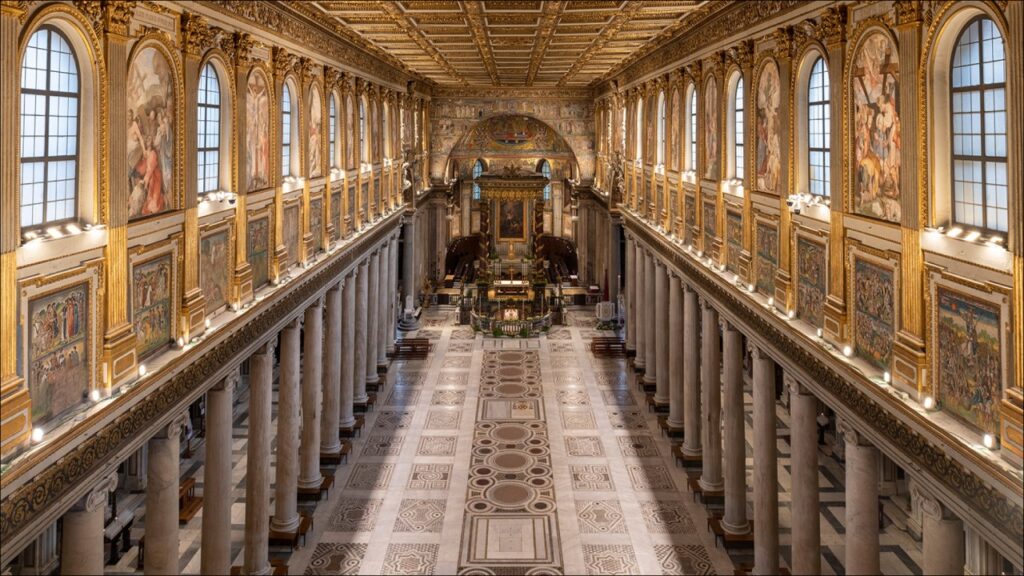
Perched atop the Esquiline Hill, the Basilica di Santa Maria Maggiore is one of Rome’s four patriarchal basilicas and among the most magnificent. Built in the 5th century, it occupies the legendary site where snow is said to have miraculously fallen in August of 358 CE—a miracle still commemorated each year on August 5 with a light show and petal shower in Piazza Santa Maria Maggiore.
Santa Maria Maggiore is a stunning blend of artistic and architectural styles shaped by centuries of renovation. Its 14th-century Romanesque bell tower—Rome’s tallest at 75m (246ft)—rises behind an elegant 18th-century Baroque facade, while inside, the layout still reflects the original 5th-century basilica.
Facade & Mosaics: The exterior facing the piazza is adorned with glowing 13th-century mosaics by Filippo Rusuti, partially hidden behind Ferdinand Fuga’s Baroque loggia.
Nave & Arch Mosaics: Inside, brilliant 5th-century mosaics light up the triumphal arch and nave, telling stories from the Old Testament.
Apse: The 13th-century apse mosaic, created by Jacopo Torriti, depicts the Coronation of the Virgin Mary, shimmering with medieval elegance.
Flooring: Underfoot lies intricate 12th-century Cosmatesque paving, a masterpiece of inlaid marble design.
At the high altar, a gilded baldachin stands over a porphyry sarcophagus, believed to hold relics of St Matthew and other martyrs.
In the Confessio below, a statue of Pope Pius IX kneels before a crystal reliquary said to contain a fragment of Jesus’ manger.
Near the altar, a floor plaque marks the burial site of Gian Lorenzo Bernini and his father Pietro.
Cappella Sistina (right side): Richly decorated by Domenico Fontana, this chapel holds the tombs of Popes Sixtus V and Pius V.
Cappella Sforza (left side): A more modest but refined space, designed by Michelangelo.
Museo del Tesoro (Treasury Museum): Accessed through the souvenir shop, it features sacred artifacts, chalices, and papal items.
Loggia delle Benedizioni: A hidden gem, reachable via 30-minute guided tours (English), where you can admire Rusuti’s facade mosaics up close.
Hours: Open daily from 7am to 6:45pm.
Admission:
Basilica: Free
Museum: €3
Archaeological tour (underground): €5
Location: Just 500m from Termini Station, easily accessible on foot.
WhatsApp us